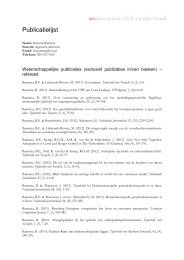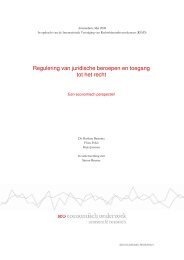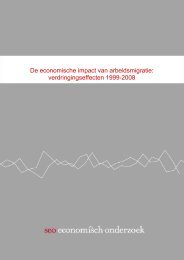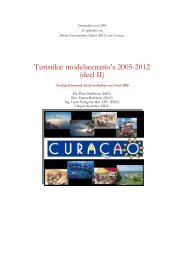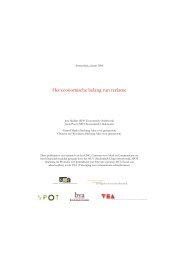Amsterdam, Netherlands - SEO Economisch Onderzoek
Amsterdam, Netherlands - SEO Economisch Onderzoek
Amsterdam, Netherlands - SEO Economisch Onderzoek
Create successful ePaper yourself
Turn your PDF publications into a flip-book with our unique Google optimized e-Paper software.
3 CONTRIBUTION OF RESEARCH TO REGIONAL INNOVATION3.1 IntroductionThis chapter focuses on the contribution of research to regional innovation. Key issues that willbe discussed are:• The Dutch government’s policy on innovation;• The regional innovation strategy of the <strong>Amsterdam</strong> metropolitan region;• Key clusters of economic activity with a high innovation potential;• The interaction between <strong>Amsterdam</strong> HEIs and regional needs and demands;• Interfaces facilitating knowledge exploitation and exchange.Section 3.2 presents a theoretical framework of the Dutch innovation system, followed by thenational legal and funding framework. Section 3.3 explains how the <strong>Amsterdam</strong> metropolitanarea is positioned in the national innovation strategy. Section 3.4 analyzes the regional innovationstrategy of the <strong>Amsterdam</strong> metropolitan region. Section 3.5 discusses the importance ofinnovative clusters for the local economy. Section 3.6 analyzes to what extent HEIs in the<strong>Amsterdam</strong> region respond to regional needs and demands. Section 3.7 discusses whatmechanisms have been developed at HEIs to commercialize their research base and to promotetechnology exchange with regional stakeholders. Section 3.8 summarizes and concludes.3.2 Framework conditions for promoting research and innovation3.2.1 A theoretical frameworkA basic typology of the Dutch innovation system is illustrated in Figure 3-1. According to areport published by the OECD, in the <strong>Netherlands</strong> output and productivity of both public andprivate R&D efforts – in terms of patents and publications – stand out favorably in internationalbenchmarking. However, output in terms of new or substantially improved products in sales issubstantially below EU average (OECD, 2003: 9). Overall, the report concludes that the favorablescore on (public) research output contrasts with the score on economic output (labor productivitygrowth, output in terms of new or substantially improved products in sales, etc.), pointing toinefficiencies in market and non-market interactions within the innovation system (ibid: 9). In thisrespect, the weakest element of the Dutch innovation system lies in the inadequate interaction andineffective institutional arrangements between the science and business system with low levels ofknowledge transfer between universities and companies as a consequence (Klomp and Roelandt,2004: 371). In the <strong>Netherlands</strong>, the quality of scientific research is high but the level ofknowledge commercialization is below international standards (ibid: 371). The Dutch policychallenge is therefore to combine excellent research output with an increasing level R&Dcollaboration between Higher Education Institutions (HEIs) and businesses (ibid: 371).53






